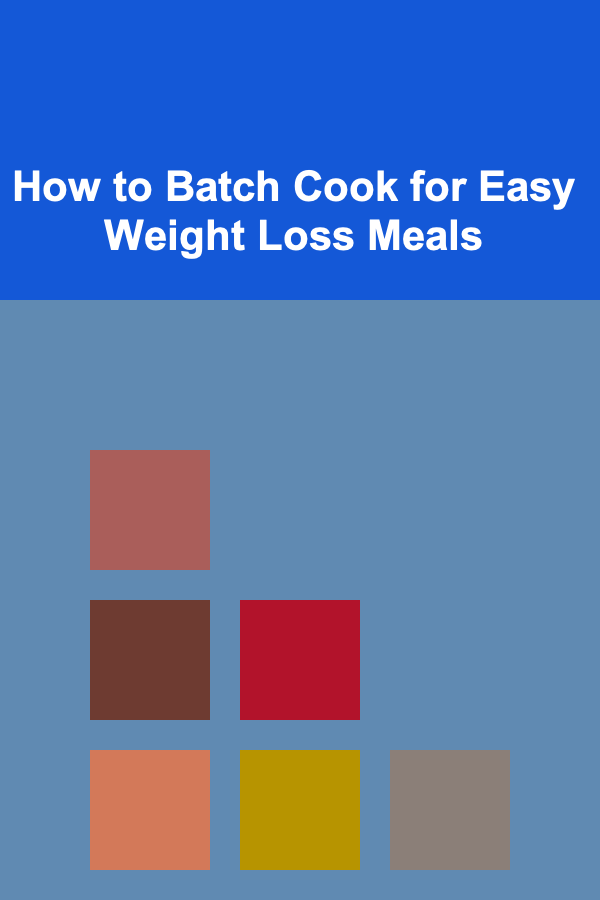
How to Batch Cook for Easy Weight Loss Meals
ebook include PDF & Audio bundle (Micro Guide)
$12.99$7.99
Limited Time Offer! Order within the next:

Introduction
In the fast-paced world we live in, it's easy to skip meals or choose unhealthy options due to lack of time or convenience. However, preparing healthy meals in advance can be a game-changer for those looking to lose weight or maintain a balanced diet. Batch cooking is a time-efficient, cost-effective strategy that can help you take control of your eating habits, improve your nutrition, and stay on track with your weight loss goals.
In this article, we'll explore how batch cooking can play a significant role in weight loss, the key principles to follow, and practical tips for preparing meals that support your health goals. Whether you're new to meal prep or looking to refine your strategy, this comprehensive guide will provide you with the knowledge and tools you need for success.
What is Batch Cooking?
Batch cooking is the practice of preparing large quantities of food at once, typically for the purpose of having ready-to-eat meals throughout the week. It involves cooking ingredients or full meals in bulk and then storing them in portions to be consumed over several days. This process saves time, reduces stress, and ensures that healthy options are always available when hunger strikes.
For weight loss, batch cooking offers the added benefit of portion control, making it easier to stick to calorie goals without the temptation of overeating or resorting to unhealthy takeout.
Benefits of Batch Cooking for Weight Loss
- Portion Control: When you cook meals in bulk, it's easier to control portion sizes. You can divide your food into smaller containers, ensuring you don't overeat, which is one of the main challenges people face when trying to lose weight.
- Nutrient-Dense Meals: Batch cooking allows you to plan your meals ahead of time and ensure they are well-balanced with a good mix of protein, healthy fats, and complex carbohydrates. By controlling what goes into each dish, you can ensure your meals are packed with nutrient-dense ingredients that support weight loss.
- Saves Time: Batch cooking cuts down on the amount of time you spend cooking throughout the week. Instead of cooking every day, you only need to cook once or twice a week, making it easier to maintain a consistent healthy eating routine.
- Reduces Stress: Having meals already prepared reduces the mental strain of having to think about what to eat, especially after a long day. This reduces the likelihood of opting for unhealthy convenience foods.
- Cost-Effective: Buying ingredients in bulk for batch cooking can save you money. You can take advantage of sales, buy in-season produce, and reduce food waste by using leftovers creatively.
Key Principles for Successful Batch Cooking
1. Plan Ahead
Planning is crucial when it comes to batch cooking. Begin by creating a meal plan for the week, including breakfast, lunch, dinner, and snacks. Choose recipes that are easy to prepare, nutritious, and suitable for storing in the fridge or freezer. A well-thought-out plan ensures that you have a balanced selection of meals and that you're not repeating the same thing every day.
2. Choose Versatile Ingredients
Choose ingredients that can be used in multiple meals throughout the week. For example, roasted vegetables, grilled chicken, or quinoa can be incorporated into different dishes like salads, wraps, or grain bowls. This versatility will save you time and reduce food waste.
3. Prep in Bulk
When batch cooking, cook in large quantities and portion out meals accordingly. For instance, cook a big pot of quinoa, roast several trays of vegetables, or prepare a large batch of lean protein like chicken or turkey. Having these basic ingredients ready to go will make it easy to assemble healthy meals throughout the week.
4. Keep Your Meals Balanced
Ensure that your meals are balanced with protein, healthy fats, fiber, and carbohydrates. A healthy plate should have 1/4 protein, 1/4 carbs, and 1/2 vegetables. Protein and fiber-rich foods help keep you full longer, which is essential for weight loss. Examples of weight loss-friendly protein sources include chicken breast, fish, tofu, lentils, and beans.
5. Invest in Good Storage Containers
To maintain the freshness and quality of your meals, invest in high-quality storage containers. Opt for glass containers that can be microwaved and are airtight to prevent food from spoiling. Clear containers will also help you easily see what you have stored, making it more likely that you'll use everything up before it goes bad.
6. Embrace Freezing
Batch cooking doesn't mean you need to eat the same meal every day. Freeze individual portions of meals or ingredients like soup, stir-fry, or cooked grains. This allows you to have a variety of meals available without having to cook every time. When you're ready to eat, just thaw and heat up.
How to Batch Cook for Easy Weight Loss Meals
Now that we've covered the basics, let's dive into practical steps for preparing easy weight loss meals with batch cooking.
Step 1: Choose Your Recipes
Start by selecting a few simple recipes that are easy to prepare and support your weight loss goals. Here are some ideas:
- Grilled chicken with roasted vegetables: A simple yet flavorful combination of lean protein and fiber-packed veggies.
- Quinoa and black bean salad: A great source of plant-based protein, fiber, and complex carbs.
- Turkey chili: A hearty, protein-rich meal that's perfect for batch cooking and freezing.
- Baked salmon with steamed broccoli: A healthy meal that's high in omega-3 fatty acids and low in calories.
- Egg muffins with spinach and feta: These make for a perfect breakfast or snack, providing protein and healthy fats to keep you satisfied.
Step 2: Shop for Ingredients
Once you've selected your recipes, make a shopping list of all the ingredients you'll need. Look for fresh produce, lean proteins, whole grains, and healthy fats. Opt for organic or locally grown produce when possible, and try to buy in bulk to save money.
Step 3: Prepare Ingredients in Bulk
When you're ready to start cooking, begin by washing and chopping vegetables, marinating proteins, and cooking grains or legumes. For example:
- Roast a large tray of mixed vegetables like sweet potatoes, zucchini, and bell peppers.
- Cook a big batch of quinoa or brown rice.
- Grill several chicken breasts or cook a large portion of lean ground turkey.
Having all of your ingredients prepped and ready to go will save you time and help you stay organized throughout the week.
Step 4: Assemble Meals
Once you've cooked your ingredients, it's time to assemble your meals. Portion out your protein, carbs, and vegetables into separate containers for the week. For example:
- Chicken breast with roasted vegetables and quinoa.
- A big salad with mixed greens, black beans, and a light vinaigrette.
- Turkey chili with a side of steamed broccoli.
Be mindful of portion sizes. Use a food scale if needed to ensure you're sticking to the appropriate serving sizes for your weight loss goals.
Step 5: Store and Freeze
Store your meals in airtight containers and label them with the date they were prepared. Refrigerate meals you plan to eat within the next 3-4 days, and freeze the rest for later use. If you're freezing meals, be sure to let them cool completely before placing them in the freezer to prevent bacterial growth.
Step 6: Reheat and Enjoy
When you're ready to eat, simply grab your pre-portioned meal from the fridge or freezer and reheat it. Use the microwave, stovetop, or oven to heat your meals to your desired temperature. Keep in mind that certain meals, such as soups or stews, may need to be reheated with a little extra liquid.
Tips for Staying on Track with Batch Cooking for Weight Loss
- Prep Snacks: Don't forget to prepare healthy snacks as well. Pre-portion servings of fruits, vegetables, or nuts to avoid mindless snacking.
- Stay Flexible: While it's important to have a plan, allow for flexibility. If you get tired of a particular dish, swap it out for something else that fits your goals.
- Hydrate: Don't focus solely on food; staying hydrated is also key for weight loss. Drink plenty of water throughout the day to support your metabolism and prevent overeating.
- Use Spices and Herbs: Keep meals flavorful by using a variety of spices and herbs. They can add depth and taste without adding unnecessary calories or sodium.
- Don't Overcomplicate: Keep your meals simple. Batch cooking doesn't have to be fancy or time-consuming. Stick to whole foods, lean proteins, and plenty of vegetables to create nutritious meals without the hassle.
Conclusion
Batch cooking is an effective strategy for anyone looking to lose weight or maintain a healthy diet. By preparing meals in advance, you can save time, money, and effort while ensuring that you always have healthy, portion-controlled meals ready to go. With the right planning, a little effort, and a commitment to consistency, batch cooking can help you stay on track with your weight loss journey.
By following the steps and tips outlined in this article, you can easily incorporate batch cooking into your routine and start enjoying the benefits of healthier, stress-free eating. So, grab your apron, plan your meals, and get cooking!

How To Manage Your Time Effectively to Pursue FIRE
Read More
How to Organize a Virtual Party for Friends at Home
Read More
How to Sell Homemade Natural Beauty Products on Etsy: An Actionable Guide
Read More
How to Set the Right Rent Price for Your Rental Property
Read More
Start Here: How to Start a Blog
Read More
How to Create a Minimalist Lifestyle That Lasts
Read MoreOther Products

How To Manage Your Time Effectively to Pursue FIRE
Read More
How to Organize a Virtual Party for Friends at Home
Read More
How to Sell Homemade Natural Beauty Products on Etsy: An Actionable Guide
Read More
How to Set the Right Rent Price for Your Rental Property
Read More
Start Here: How to Start a Blog
Read More